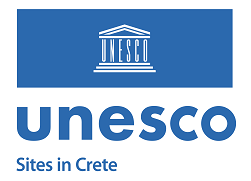Activities
Hiking
The Asterousia mountains have an extensive network of organised trails that run through mountainous and coastal areas, south of the prefecture of Heraklion. Within these trekking routes you can admire unique views and a wild and charming mountainous landscape. You can also reach beaches, secluded coves, monasteries, and caves. Many of the routes are signposted, while the degree of difficulty varies.
The area has more than 60 hiking paths, 14 of which are specially designed routes that combine mountainous and lowland elements. Natural and cultural points of interest are integrated into one network of hiking routes.
Most routes start in the middle of the mountain and end in the south of the region. A popular route is the one towards the peak of Kofinas, which crosses Agiofarago and passes the Monastery of Agios Nikitas, Tris Eklisies, and the Monastery of Koudoumas.
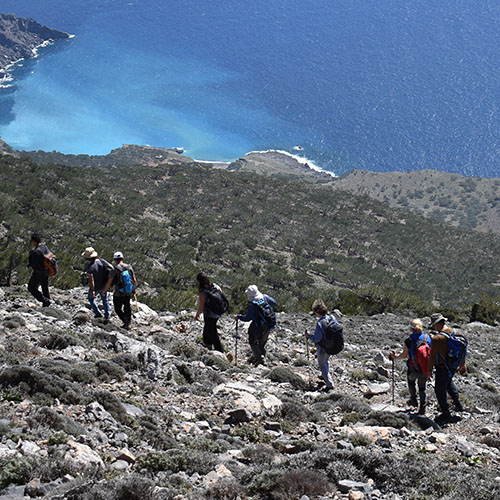
Climbing
The dramatic topography of Asterousia and the different types of rocks that develop within it create areas of special natural beauty, that are organised for climbing. There are 12 climbing fields in total, with 220 climbing routes of varying degrees of difficulty, in the areas of Kapetaniana and Agiofarago.
Near Kofinas, the highest peak of Asterousia, is the village of Kapetaniana, at 750m height. In this area there are 180 climbing routes in total, like the ones at Tris Eklisies and Agios Ioannis.
To the south of the prefecture, in Agiofarago, there are six climbing routes.
Smaller routes are located to the east, at the exit of the gorge of Trafoulas, near the cave of Agios Antonios and in Ambas gorge.
For adventure lovers, there are seven via ferrata (paths with metal footholds and wire ropes) in the centre of Asterousia. They are located on a steep slope and equipped with ropes, cables, and iron stairs.
The recommended period for climbing is spring to autumn. However, it is better to avoid climbing during the reproductive months of the birds of prey who nest on the rocks (December to February).
For more information and a safer climbing experience, contact the local mountaineering club.
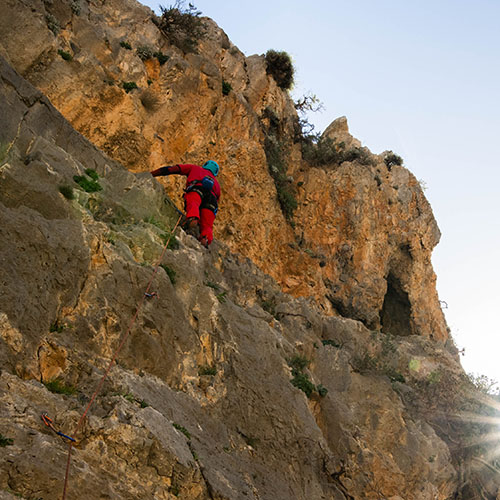
Geotourism
Asterousia is part of the Biosphere Reserve network (MAB: Man and Biosphere). It spans 367km2 and includes a variety of geotopes like rock formations, fossils of sirenia (sea cows), hipparions, and plants, gorges, caves, remote slopes and cliffs and rock formations. Those interested in geology have a lot to discover in this rare and unexplored mountainous corner of Crete.
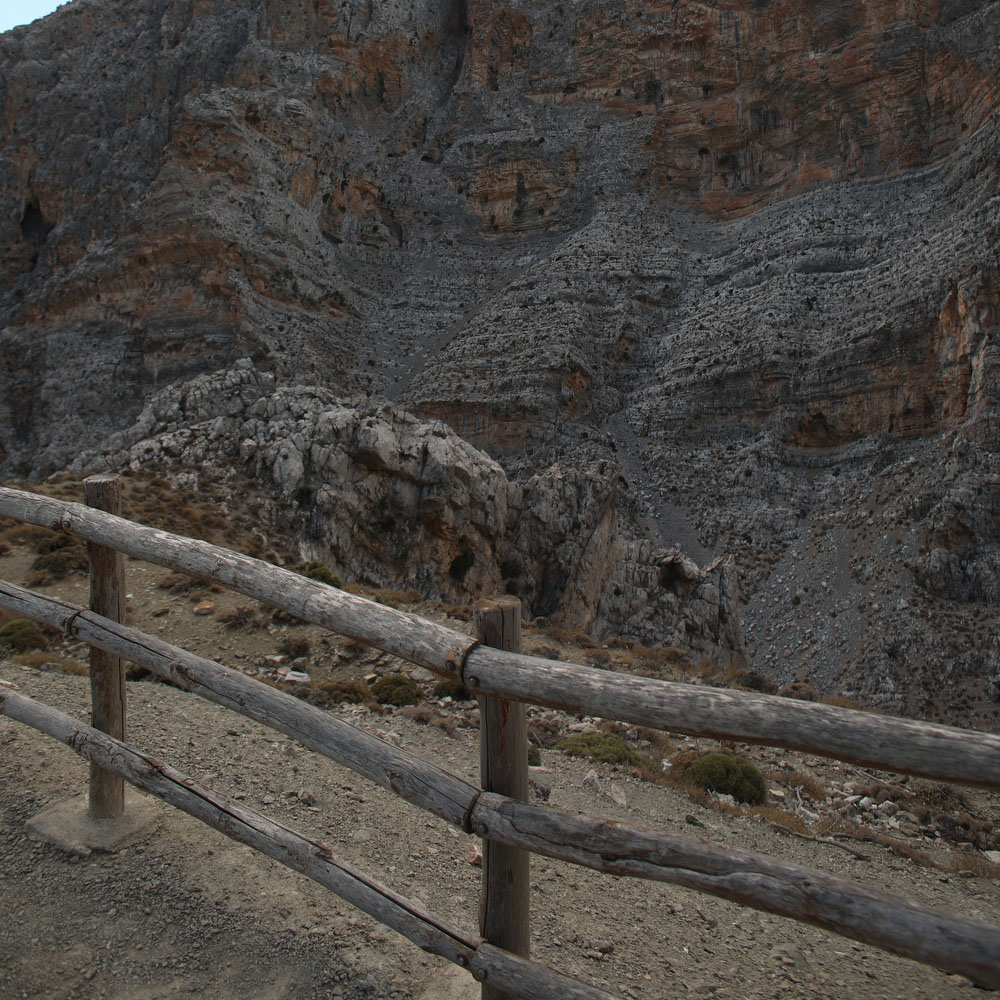
Canyoning
The geomorphology of Asterousia has created many surprisingly deep gorges for such a small area. The southern part of the region consists of gorges and steep slopes that reach the Libyan Sea. To the west, the topography is gentler and the smaller height differences create more accessible gorges.
Asterousia is an important canyoning destination as it has more than 20 gorges that you can only cross with special gear. They require experience, and they are secured and controlled by canyoneering clubs and teams.
These gorges include Elygia (Valahas), Agia Paraskevi, Mesosfini, Tripiti, Koudoumas, Tsoutsouras, Pervoliano, Troula, Ethiano and Ambas. They have degrees of difficulty from medium to high and require experience and equipment. The gorges of Maridaki, Mintris, Martsalo, Agiofarago, Trafoulas and Agios Savvas are accessible to all, and you can hike them.
The geological history of the area is imprinted in the walls of the gorges, and you can also observe many endemic species of plants and birds. The imposing landscape is complemented by waterfalls in Troulas, Tsoutsouras, Tripiti, Pervoliano, Koudoumas. The highest waterfall of the island, Ambas, is also located here at 140m high.
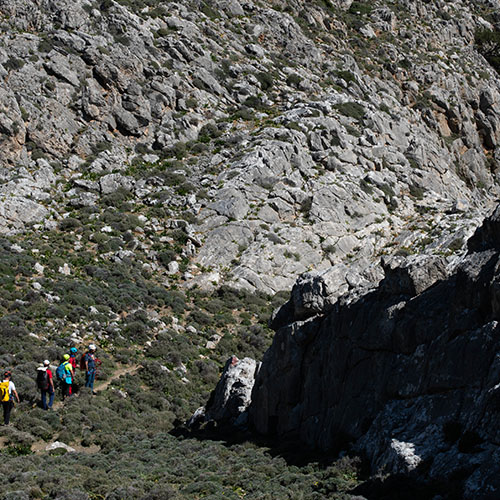
Caving
The region of Asterousia has several small caves with few stalagmites and stalactites. They have great cultural interest as they have been used from prehistoric times until today as residences, shelters, hermit dwellings, or places of worship.
Many of the caves remain unexplored and are not open for visits. Some of the known caves of Asterousia are Kassiani, Sarakinospilios, Peristeria, Varvakospilios, Plakospilios and Ble.
The cave of Miamou and Eileithyia present archaeological interest, while the caves of Goumenospilios and Agios Antonios are inextricably linked with the religious and ascetic history of Asterousia. A path leads to the cave of Agios Antonios with its impressive decoration, 35m high entrance, a small church, and a magnificent view to the sea. Within the gorge of Agiofarago you can see Goumenospilios, one of the oldest hermit sites. The cave has a small entrance and an impressive, vaulted ceiling with an opening. According to tradition, 300 hermits used to live inside the cave and communicated between them only once a year, on the day of the Resurrection of Christ.
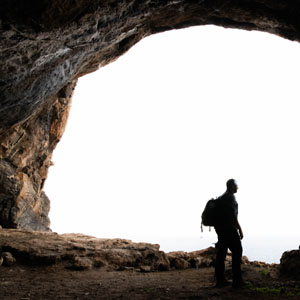
Bird watching
The rugged terrain, steep gorges, and coastal areas of Asterousia are an ideal place of residence for the birds of the southernmost mountain range in Europe. You can see both endemic and migratory species because the area provides different habitats and access to coastal zones. You can find at least 192 species of birds here, a particularly high number for such a small area.
Over 29 species of birds of prey find refuge in secluded gorges in the centre of Asterousia. Of note is the bearded vulture (kokalas), as well as the griffon vulture. You can watch the birds at the Forest Observatory and the bird feeder close to the monastery of Koudoumas, as well as at the viewing spots in Kofinas and Madara. In the coastal areas, there are migratory birds of prey as well as small birds in spring, when they travel from Africa to Europe. You can also see them in autumn when they go back to Africa.
Representative species are: the shag, golden eagle and lanner falcon on steep rocky areas, the little bittern, the night heron, the squacco heron, the little egret, the purple heron at the mouth of Anapodaris river, the black stork, black kite and common pern in areas with vegetation and forests, the eastern imperial eagle, the steppe eagle, the Ruppell’s warbler in the Mintris valley, the alpine chough in the peak of Kofinas and the gorge of Achendria, the ortolan in scrublands and the short-toed eagle in areas with shrub vegetation.
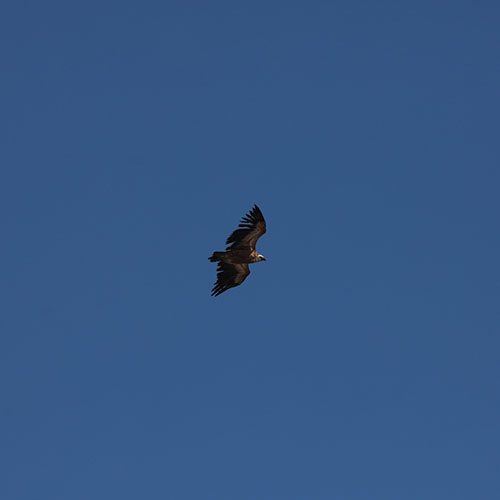
Horse riding
Α special way to get to know the unique natural beauty of the area is horse riding. There are itineraries that start from the mountains and end in the lowlands or on the coast. They can cover distances from 7 to 40km and are suitable even for novice riders. For equestrian activities you can find relevant spots in Kapetaniana, Matala and Kommos.
Cycling
The area of Asterousia has a large network of rural roads and is ideal for cycling. Most routes are in mountainous and semi-mountainous areas and are not signposted. We propose a total of eight routes of varying degrees of difficulty. The dirt roads and steep slopes require good physical condition. The recommended period for cycling is from April to mid-November, except for very hot summer days.
The routes of Pyrgos, the circular route of Achendria, the circular route of Charakas to the north and the downhill route of the Monastery of Agios Nikitas to the east are more demanding, due to the large slopes and the barren, mountainous terrain. The routes to the south and southwest (Tris Eklisies, the route from Ethia to Pervolas, from Paranyfes to Agios Pavlos and from Kapetaniana to Panagia of Kofinas) are more accessible. The downhill routes offer excellent views to the Libyan Sea, while the circular ones provide a unique opportunity to explore the natural landscape and the villages in the Asterousia mountains.
Paragliding
When it comes to extreme sports and for an intense experience, you can enjoy the topography and the natural environment of Asterousia from above with paragliding. You can find organised spots for take-off and landing in the area of Lendas. There are also some other non-organised spots. For more information regarding paragliding please contact the aeroclub of Heraklion.


